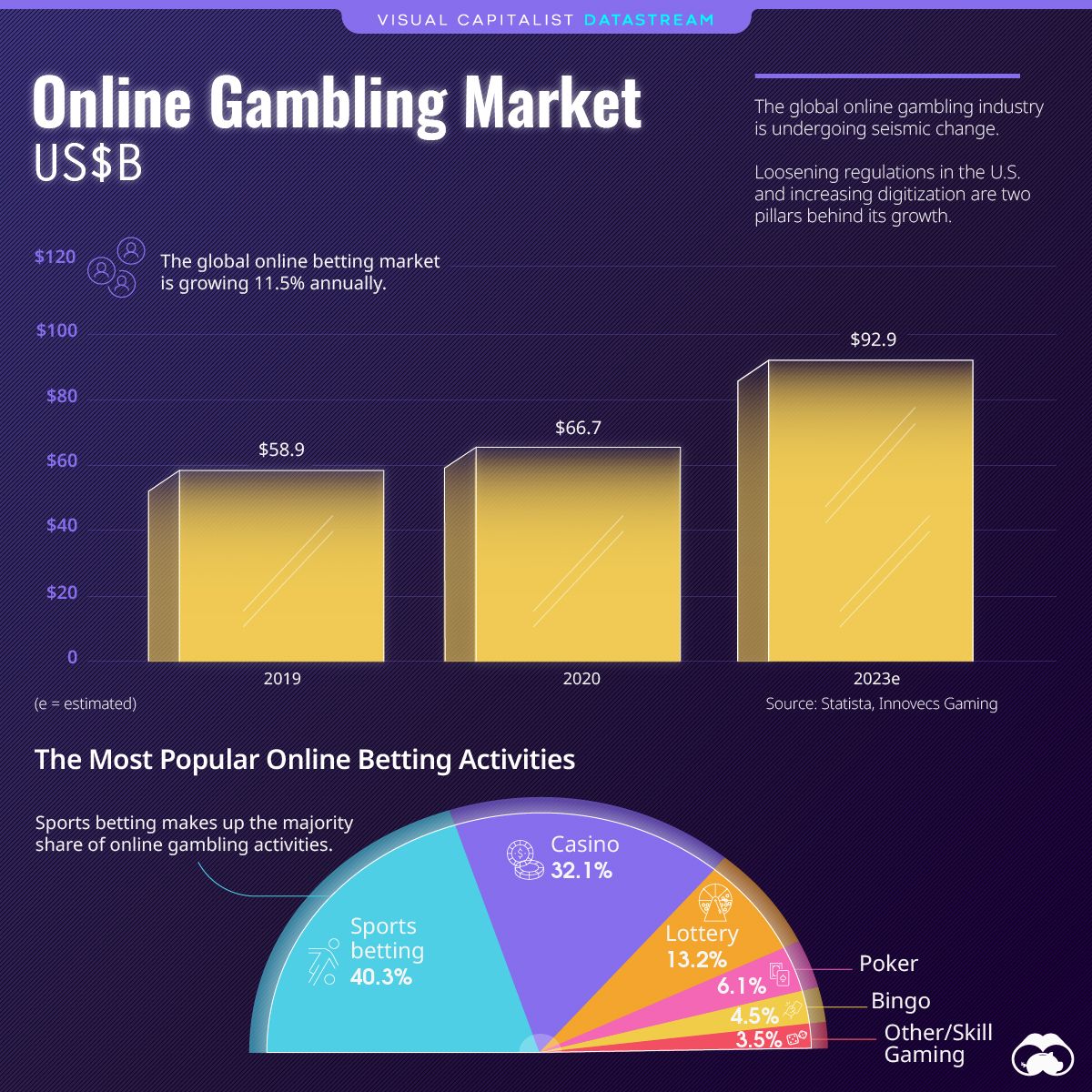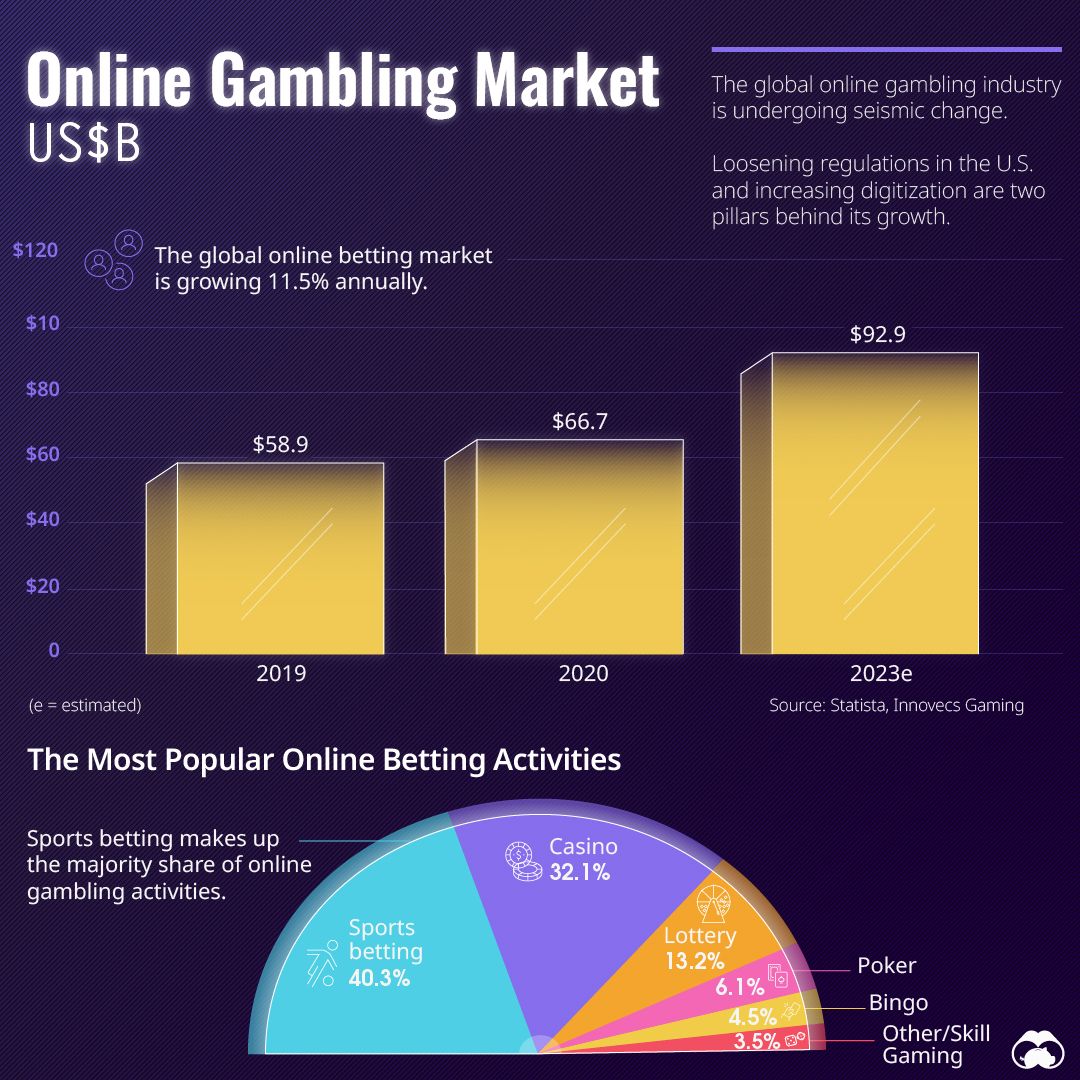Datastream
The Staggering Numbers Behind the Online Betting Industry

The Briefing
- The global online gambling market is expected to reach $93 billion by 2023—a 40% jump from its value today
- Sports betting has been a major growth driver, after the U.S. Supreme Court legalized it federally in 2018
The World of the Online Betting Industry
The world of online betting is undergoing tremendous change, setting it up to flourish in the years to come. The market is worth $67 billion today and estimated to reach about $93 billion by 2023—growing at roughly 11.5% per annum.
There are two trends that are bringing about this growth. First, more of our activities are taking place online, a trend that extends to betting as well.
Second, is loosening regulation. The U.S. Supreme Court uplifted the Professional and Amateur Sports Protection Act in May of 2018 to legalize sports betting on a federal level. Since then, over two dozen (plus Nevada) have followed through, taking the state tally to 25.
The Most Popular Online Betting Activities
Online betting activity breaks up into a few unique categories. Casino is a big one, making up 32% of all online betting activity. It appears traditional casino games like blackjack carry the same thrill online. Bingo’s popularity is a lot more modest at 4.5%.
But the most popular activity by far is sports betting, which makes up over 40% of the total online betting market—and the $66 billion in value it encapsulates.
| Online Betting Activity Type | Share of Total |
|---|---|
| Sports Betting | 40.3% |
| Casino | 32.1% |
| Lottery | 13.2% |
| Poker | 6.1% |
| Bingo | 4.5% |
| Other / Skill Gaming | 3.5% |
Betting On Betting
The numbers behind sports betting are truly staggering.
Since the Supreme Court’s decision, $57 billion in legal sports bets have been made, $4.1 billion in revenues have been generated, and $571 million has been collected in tax or jurisdiction revenues.
And these numbers reflect activity in some 20 states. The total count is expected to reach some 40 states in the years to come, brewing optimism towards the industry.
The surge in betting has trickled into the world of investing. The BETZ ETF, one of only two betting ETFs, has over doubled the performance of the S&P 500 since its inception.
It appears investors are now betting on betting.
Where does this data come from?
Source: Innovecs Gaming
Notes: Betting activity popularity is rounded off to the first decimal
Datastream
Can You Calculate Your Daily Carbon Footprint?
Discover how the average person’s carbon footprint impacts the environment and learn how carbon credits can offset your carbon footprint.

The Briefing
- A person’s carbon footprint is substantial, with activities such as food consumption creating as much as 4,500 g of CO₂ emissions daily.
- By purchasing carbon credits from Carbon Streaming Corporation, you can offset your own emissions and fund positive climate action.
Your Everyday Carbon Footprint
While many large businesses and countries have committed to net-zero goals, it is essential to acknowledge that your everyday activities also contribute to global emissions.
In this graphic, sponsored by Carbon Streaming Corporation, we will explore how the choices we make and the products we use have a profound impact on our carbon footprint.
Carbon Emissions by Activity
Here are some of the daily activities and products of the average person and their carbon footprint, according to Clever Carbon.
| Household Activities & Products | CO2 Emissions (g) |
|---|---|
| 💡 Standard Light Bulb (100 watts, four hours) | 172 g |
| 📱 Mobile Phone Use (195 minutes per day)* | 189 g |
| 👕 Washing Machine (0.63 kWh) | 275 g |
| 🔥 Electric Oven (1.56 kWh) | 675 g |
| ♨️ Tumble Dryer (2.5 kWh) | 1,000 g |
| 🧻 Toilet Roll (2 ply) | 1,300 g |
| 🚿 Hot Shower (10 mins) | 2,000 g |
| 🚙 Daily Commute (one hour, by car) | 3,360 g |
| 🍽️ Average Daily Food Consumption (three meals of 600 calories) | 4,500 g |
| *Phone use based on yearly use of 69kg per the source, Reboxed | |
Your choice of transportation plays a crucial role in determining your carbon footprint. For instance, a 15 km daily commute to work on public transport generates an average of 1,464 g of CO₂ emissions. Compared to 3,360 g—twice the volume for a journey the same length by car.
By opting for more sustainable modes of transport, such as cycling, walking, or public transportation, you can significantly reduce your carbon footprint.
Addressing Your Carbon Footprint
One way to compensate for your emissions is by purchasing high-quality carbon credits.
Carbon credits are used to help fund projects that avoid, reduce or remove CO₂ emissions. This includes nature-based solutions such as reforestation and improved forest management, or technology-based solutions such as the production of biochar and carbon capture and storage (CCS).
While carbon credits offer a potential solution for individuals to help reduce global emissions, public awareness remains a significant challenge. A BCG-Patch survey revealed that only 34% of U.S. consumers are familiar with carbon credits, and only 3% have purchased them in the past.
About Carbon Streaming
By financing the creation or expansion of carbon projects, Carbon Streaming Corporation secures the rights to future carbon credits generated by these sustainable projects. You can then purchase these carbon credits to help fund climate solutions around the world and compensate for your own emissions.
Ready to get involved?
>> Learn more about purchasing carbon credits at Carbon Streaming
-

 Debt1 week ago
Debt1 week agoHow Debt-to-GDP Ratios Have Changed Since 2000
-

 Markets2 weeks ago
Markets2 weeks agoRanked: The World’s Top Flight Routes, by Revenue
-

 Demographics2 weeks ago
Demographics2 weeks agoPopulation Projections: The World’s 6 Largest Countries in 2075
-

 Markets2 weeks ago
Markets2 weeks agoThe Top 10 States by Real GDP Growth in 2023
-

 Demographics2 weeks ago
Demographics2 weeks agoThe Smallest Gender Wage Gaps in OECD Countries
-

 Economy2 weeks ago
Economy2 weeks agoWhere U.S. Inflation Hit the Hardest in March 2024
-

 Green2 weeks ago
Green2 weeks agoTop Countries By Forest Growth Since 2001
-

 United States2 weeks ago
United States2 weeks agoRanked: The Largest U.S. Corporations by Number of Employees







